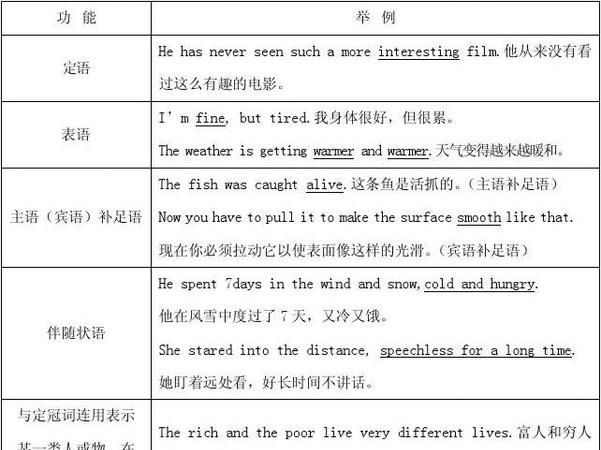本文目录
形容词修饰名词什么时候放在后面
形容词在句中的位置:
1、单个形容词作定语时, 一般放在被修饰的名词之前; 两个或两个以上的形容词修饰一个名词时, 同种类形容词的排列顺序一般应考虑以下两种情况:
①和被修饰的名词关系比较密切的形容词位置更靠近名词
a. It is a touching English film.
②音节少的形容词在前, 音节多的形容词在后
a. I have a small but beautiful room.
不同种类的词同时出现在名词前作定语时, 按以下顺序进行排列:
2、单个形容词作定语时, 在下列情况之下, 形容词应放在被修饰的词之后
①形容词修饰不定代词something, nothing, anything等时应后置
a. Is there anything important in the article?
b. There is something difficult in the lesson.
c. There is nothing wrong in your homework.
②形容词修饰表示度量的名词应后置
a. The building is seventeen storeys high.
b. He is ten years old.
c. The street is five hundred meters long.
③用and / or连接的两个形容词通常放在被修饰的名词之后, 起强调修饰语的作用
a. We will turn our motherland into a country, strong and modern.
b. Every nation, big or small, has its rights.
c. Power stations, large and small, have been set up all over the country.
④有些过去分词形容词作定语时应后置, 如: given, left, won, missed等
a. None of the answers given (被给的答案) were correct.
⑤表语形容词作定语时需后置, 如: alive, present, possible等
a. He is the greatest writer alive.
b. He was the only person awake at the moment.
3、形容词短语作定语时, 需要后置
a. He is a worker worthy of praise.
b. This is a problem difficult to solve.
c. She is always ready to help others.

拓展资料
形容词用法讲解
一、形容词的定义: 形容词表示人或事物的性质, 特征或状态, 修饰名词或不定代词
二、形容词在句中的作用:
1、作定语:
a. He is a great writer.
b. This is an interesting book.
c. I have something important to tell you.
2、作表语:
a. The bridge is long and wide.
b. It is getting warm.
3、作补语(宾语补足语或主语补足语):
a. The news made her happy.
b. We found the text very difficult.
c. You should keep your classroom clean.
d. The classroom should be kept clean.
4、作主语或宾语: the+adj表示某一类人或事物, 这种名词化的形容词起着名词的作用, 在句中可以作主语或宾语
a. We should respect the old and love the young.
b. The new will replace the old.
c. The rich and the poor live in separate sections in London.
5、作状语: 形容词作状语时, 多用来说明一个名词或代词的情况
a. Unhappy with the result, he returned to work.
b. Long and tidy, his hair played in the breeze.
c. Anxious for a quick decision, we called for a vote.
三、关于形容词的作用要注意的问题:
1、有些形容词只能作表语和补语, 不能象普通形容词那样作前置定语, 这样的形容词称为表语形容词, 如: alive, alone, asleep, alike, afraid, awake, ashamed, able, sure, ill, worth等词; 表语形容词作定语时需后置
2、有些形容词只能作定语, 不能作表语, 这样的形容词称为定语形容词, 如: golden, wooden, silken, live(活的), elder(年长的), former前任的, latter后者, front前面的, back后面的, outer外部的
形容词后置
形容词后置的规律如下:

形容词一般用来做定语,形容词作定语修饰名词时要放在名词的前面。但以下几种情况形容词作定语需要后置。
1、当形容词修饰由any-,every-,no-,some-和-body,-one,-thing等构成的复合不定代词时,形容词需要后置。
2、当形容词修饰起名词作用的anywhere,somewhere时,通常后置。
3、以-able或-ible结尾的形容词一般充当后置定语,表示暂时的特征或现象,而且中心名词前大多有形容词最高级或all,only,every等。
4、以字母a-开头的表语形容词,如asleep,awake,afraid,afloat,alive等作定语时,通常后置。
5、else修饰疑问代词时,须后置。

6、当形容词前有so,more,most等词修饰时,常后置。
7、形容词短语通常后置,其功能相当于一个定语从句。
8、两个或两个以上的形容词用and或or连接作定语,表示强调意义时要后置。
9、形容词比较结构须后置定语。
10、有些形容词作前置定语时和后置定语时所表达的意义不同。
11、形容词修饰不定代词或地点副词时。
哪些形容词作定语必须后置
可以作后置定语有六类:介词短语、分词短语、不定式短语、形容词短语、定语从句和同位语从句。
the man busy working is my relative.和the woman dressed in gorgeous skirt is my friend.
都属于分词短语的情况。
而the people late for school is his children.
属于形容词短语的情况。

英语学习方法
1、英语基础
要想学好高三英语,英语基础是必须学好的,英语基础没有想象中的那么难,不管是单词还是句型、语法。
在高三复习的第一轮复习中,关于复习系会和语言点,一定要注意听,哪怕是一节课掌握几个短语也行,至于课后就自己拿起高中英语书,从单词背起,考英语一定要有词汇基础,否则什么都是白搭。
2、词典不离手
当在学习高三英语的时候,遇到不会的单词就要查,看到相近的单词分不清也得查明白,不要求自己一遍记住,就看一看给自己一个印象,大概一个单词你查五遍的时候就能记住了。
形容词作后置定语有哪些基本情况
下面的回答 供参考
1.修饰不定代词时:修饰somebody,someone,something,anybody,anyone,anything,nobody,nothing等复合不定代词的形容词,则必须放在不定代词之后.如:
This isn’t anything important.这并不是什么重要的东西.
Anyone intelligent can do it.任何有脑子的人都能做这事.
There’s nothing wrong with the machine.机器没有毛病.
Let’s talk about something interesting.我们来谈论一些有趣的事吧.
2.形容词短语作定语时:形容词短语作定语必须放在所修饰的名词之后.如:
I think he is a man suitable for the job.我认为他是适合做这项工作的人.
We need a place twice larger than this one.我们需要一个比这里大一倍的地方.
3.成对的形容词作定语时:有时成对的形容词作定语,考虑到句子的节奏和平衡,可以后置.如:
There was a huge cupboard,simple and beautiful.有一个大食橱,简朴而美观.
She has many pencils,blue and red.她有许多铅笔,有蓝的、红的.
4.表语形容词作定语时:当表语形容词作定语时必须放在所修饰的名词之后.如:
He must be the best violinist alive.他一定是当代最好的小提琴手了.
The house ablaze is next door to me.那家着火的房子就在我隔壁.
有时形容词作定语时,既可放在被修饰名词之前,也可放在被修饰名词之后.当past,last,next,nearby,following等作定语时,既可放在所修饰的名词之前,也可放在所修饰的名词之后.如:
in past years / in years past 过去的年月
the following days / the days following 以后的日子
另外,形容词enough,opposite等修饰名词时可前置或后置.如:
If we had enough time [time enough],things would be easy.如果时间足够,事情就好办了.
The people in the house opposite [the opposite house] never draw their curtains.对面房子里的人从来不把窗帘拉上.
注意,有的形容词前置和后置均可,但含义不同.如:
What’s your present feeling?你现在感觉如何?(present=现在的)
He was the only Englishman present.他是唯一在场的英国人.(present=在场的)
另外,有些既可用作形容词又可用作副词的词,当它用作形容词时前置,用作副词时后置.如:
upstairs rooms / rooms upstairs 楼上的房间

以上就是关于表语形容词后置例句,形容词修饰名词什么时候放在后面的全部内容,以及表语形容词后置例句 的相关内容,希望能够帮到您。
